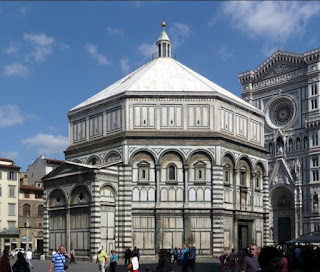Today was another early start as we were headed to Pisa and Florence. The best way I find to visit these towns is to do it independently on the train. After a short train ride were were in Pisa. Once a maritime power to rival Genoa and Venice, Pisa now draws its fame from an architectural project gone terribly wrong. But the world-famous Leaning Tower is just one of many noteworthy sights in this compelling city.
Education has fuelled the local economy since the 1400s, and students from across Italy compete for places in its elite university. This endows the centre of town with a vibrant cafe and bar scene, balancing an enviable portfolio of well-maintained Romanesque buildings, Gothic churches and Renaissance piazzas with a lively street life dominated by locals rather than tourists.
After some time in Pisa shopping for souvenirs (I got a Leaning Tower of Pisa coffee mug which leans, lol) we were back on the train to Florence.
Florence is a relatively compact historic city situated along the borders of the Arno river in the middle of the Tuscan hills. During the Renaissance period, when the city was at the height of its powers, talented artists such as Brunelleschi and Michelangelo left their mark with magnificent buildings and artwork.
The Cathedral of Florence, officially known as Cattedrale Santa Maria del Fiore but better known as the Duomo, was originally planned in 1296 as a Gothic cathedral by Arnolfo di Cambio. It replaced the church of Santa Reparata, a cathedral church with a history going back to the early Middle Ages.
The dome of the Duomo was the world's largest when it was completed in 1436 and still towers over the city. The lantern on top of the dome was added later, in 1461, by Michelozzi Michelozzo. The dome, a marvel of engineering, was designed by Brunelleschi, who submitted his plans after he went to Rome to study the Pantheon, which long had the world's largest dome.
Brunelleschi managed to create the enormous dome without supports thanks to an ingenious design which consisted of an inner shell made of bricks with a herringbone pattern and a horizontal stone chain, which reduced stress and allowed the weight to be evenly distributed. The outer, much smaller shell supports the roof and protects the inner shell from the elements. Between the two shells is a staircase, which leads visitors to the base of the lantern.
The Baptistery is one of Florence's oldest buildings and predates the cathedral. It was constructed on top of Roman foundations, possibly as early as in the sixth century. The interior dates back to the thirteenth century when the mosaics on the ceiling - depicting stories from the bible - were created. The exterior white and green marble cladding was added around the same time.
The Ponte Vecchio (Old Bridge) is a medieval bridge spanning the river Arno in Florence. It is one of the few remaining bridges with houses built upon. The Vasari corridor that runs over the houses connects the Uffizi with the Pitti Palace on the other side of the river. The pedestrian bridge is often teeming with tourists and the many musicians, portraitists and other entertainers create a constantly vibrant atmosphere. The bridge is at its most beautiful at dusk, especially when seen from the Ponte Santa Trinità.
The houses on the bridge were initially used as workshops and a diverse array of shopkeepers such as butchers and tanners did business here. In 1593 duke Ferdinand I decided to replace them with goldsmiths, reportedly because the shops produced too much garbage and caused a foul stench.
Today the houses are used as shops selling a wide assortment of jewelry, ranging from affordable modern jewels to pricey antiques. The Ponte Vecchio is the oldest bridge in Florence. It is believed that a bridge already existed here during the Roman times. Its current appearance dates back to 1345 when it was built to replace a bridge which was destroyed by a flood. Houses were built on the bridge, a common practice in large European cities during the Middle Ages. The Ponte Vecchio was the only bridge in Florence that survived the Second World War unscathed.
Today the houses are used as shops selling a wide assortment of jewelry, ranging from affordable modern jewels to pricey antiques. The Ponte Vecchio is the oldest bridge in Florence. It is believed that a bridge already existed here during the Roman times. Its current appearance dates back to 1345 when it was built to replace a bridge which was destroyed by a flood. Houses were built on the bridge, a common practice in large European cities during the Middle Ages. The Ponte Vecchio was the only bridge in Florence that survived the Second World War unscathed.

We had a great lunch at a lovely sidewalk cafe. I ordered spaghetti with meat sauce and they served it in a unique plate that had a large cup-like indentation in the middle to hold the pasta, very good meal in the most beautiful surroundings facing the Duomo.
After some shopping we headed back to the train station to return to the ship. We had a great meal tonight of shrimp cocktail, prime rib and a to-die-for chocolate souffle. After dinner we saw an entertaining show in the lounge and then happily went to bed after an exciting but tiring day.






No comments:
Post a Comment